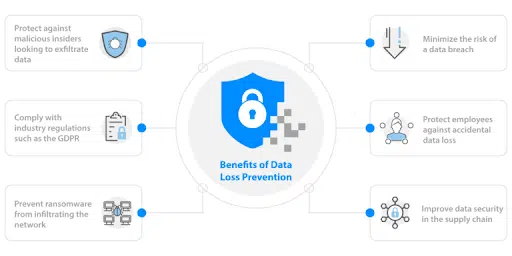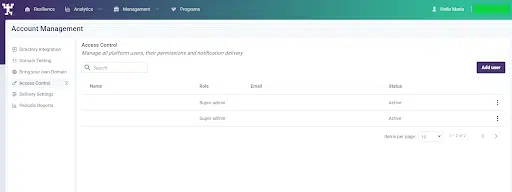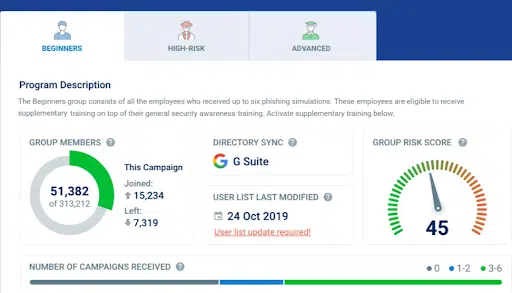As we grow more reliant on data for our day-to-day operations, organizations continue to generate increasing amounts daily. Losing data can have disastrous effects on a company’s reputation and finances. But as data threats continue to rise, securing it has become more critical than ever, so security-savvy companies have a Data Loss Prevention (DLP) Policy.
A 2022 survey revealed that 62% of companies in the Americas reported experiencing data loss in the previous 12 months. With public concern over data privacy and security increasing, the DLP market is projected to grow from $1.24 billion in 2019 to $3.5 billion by the end of 2024. The costs and incidents of data loss continue to rise, and implementing a DLP is more urgent than ever before.
In this post, we’ll explore DLP policies and why they should be a top priority for any business looking to safeguard their data and reputation.
What Is a Data Loss Prevention (DLP) Policy?
Data Loss Prevention (DLP) policy refers to a set of tools, processes, and policies implemented to prevent data loss, unauthorized access, and theft. In simpler terms, a DLP policy is a security strategy that safeguards sensitive data by identifying, monitoring, and protecting it. These policies are essential for any organization that collects, processes, and stores data.
DLP policies are designed to prevent data breaches and protect sensitive information, such as customer information, financial data, and intellectual property. Organizations can detect and prevent data leakage, accidental data sharing, and data theft by implementing a DLP policy. It is an essential component of a cybersecurity strategy that helps minimize the risk of financial loss, reputational damage, and legal consequences resulting from a data breach.

Why Your Organization Needs a DLP Policy
Organizations may incur significant costs as a result of data breaches, including financial losses and reputational damage. IBM Security’s 2022 Cost of a Data Breach Report determined that the average data breach cost is $4.35 million.
Implementing a DLP policy can significantly reduce the risk of data breaches, saving organizations potentially millions of dollars. A DLP policy can help organizations improve their overall security posture by identifying potential data loss threats before they become real problems.
A DLP policy also enables organizations to comply with regulatory requirements. With increasing data privacy and security regulations, having a DLP policy in place can help organizations avoid hefty fines for non-compliance.
In today’s digital landscape, where cyber threats continue evolving and becoming more sophisticated, a DLP policy is no longer optional but necessary. With so much at stake, every organization needs to prioritize implementing a DLP policy to mitigate the risks associated with data loss.

12 Essentials for Every Data Loss Prevention Policy
To ensure that your DLP policy is effective, it should include the following essential steps and components:
1. Identify and Classify Data
The first step in creating a DLP policy is identifying and classifying the data. This step involves understanding the type of data an organization has, where it’s stored, and who has access to it. Organizations can prioritize their data protection efforts by classifying data based on its sensitivity and importance.
2. Create Access Controls
Access controls limit who has access to sensitive data and what can be done with it. Role-based access controls and two-factor authentication are typical ways to secure access to sensitive data. Organizations should implement access controls according to the sensitivity of the data.

3. Monitor Data Activity
Regular monitoring of data activity is essential to identify and prevent data leakage. Real-time monitoring helps to detect unauthorized access or usage and enables organizations to take action before it’s too late. It also helps to detect potential threats and prevent data breaches.
4. Educate Employees
It’s common knowledge that the weakest link in an organization’s security is its employees. A robust DLP policy should include regular employee training on data security best practices, such as password management, email security, and safe browsing. Employees can become aware of the risks and how to avoid them through regular training and courses. Educating your employees allows you to transform them from a security risk to an extra layer of protection by creating a human firewall.
CybeReady offers solutions to ensure your employees’ cybersecurity skills are up to date through engaging and fresh training courses, keeping them educated and invested in your organization’s security status.

5. Establish a Security Culture
Creating a security culture within the organization is essential in preventing data loss. This step involves promoting a culture of security awareness, providing regular employee education sessions on the importance of data security, and fostering an environment of open communication between security teams and other departments.
6. Encrypt Data
Encryption is the process of protecting sensitive data from unauthorized access by converting it into an unreadable format. Implementing encryption for sensitive data is an essential component of any DLP policy and ensures that data remains secure even if hackers or criminals obtain it.
7. Implement Data Backup
Data backup is crucial in case of data loss or system failure. Regular data backup ensures that critical data is recoverable in case of a security incident. Organizations should have a backup plan to ensure they can recover data quickly and efficiently.

8. Regularly Review and Update Policies
A DLP policy is not a one-time task. It should be regularly reviewed to ensure it remains effective against new threats and changes in the organization’s data environment. The DLP should be updated to reflect changes in the organization’s data classification, access controls, monitoring, employee education, encryption, and backup plans.
9. Implement Endpoint Security
Endpoint security is essential in protecting an organization’s data. Endpoint devices like smartphones, laptops, and tablets are often used outside the organization’s network, making them vulnerable to cyber-attacks. Endpoint security solutions can detect and prevent unauthorized access to sensitive data on these devices.
10. Use Data Loss Prevention Software
DLP software can help to automate the process of identifying, monitoring, and protecting sensitive data. It can also help to enforce policies by preventing unauthorized access, usage, or transfer of sensitive data. DLP software can also alert security teams to potential threats and provide visibility into data activity. It can provide teams with the information to proactively hunt threats before they cause severe damage or loss.
11. Establish Incident Response Procedures
Every organization needs to have a plan for responding to cybersecurity incidents. The incident response plan should include steps for containing the incident, investigating the cause, and notifying stakeholders. The plan should also include procedures for restoring data and systems, along with measures for preventing future incidents.

12. Conduct Regular Security Audits
Regular security audits help to identify vulnerabilities in an organization’s security infrastructure. An independent third party should conduct audits and should include a review of access controls, data activity monitoring, encryption, backup plans, and incident response procedures.
Protect Your Data with Compliance-Driven Training Programs
Every company depends on data in the modern digital world, where it is produced, stored, and exchanged at an unparalleled rate. The increase in remote work and digital communication has further accelerated the amount of data being generated, highlighting the critical importance of DLP policies. To avoid facing the consequences of data loss, organizations must prioritize their DLP policies and ensure their policy includes all the steps necessary to ensure its effectiveness.
But it’s important to note that data security can’t exist in a vacuum. Mitigating the risks of data loss at all levels of your organization requires participation from every member. That’s why providing employees with security education and creating a security-forward culture across your organization is the most critical step of any DLP.
CybeReady offers the perfect solution to address data loss and compliance issues. Our AuditReady program helps ensure your organization is always compliant with regulations by educating your teams and keeping you ready for surprise audits at all times. All our training programs are engaging, easy to deploy, and offer high-quality employee training.
Contact CybeReady and schedule a free demo today to learn more about our comprehensive training programs that can transform your company’s security culture. With CybeReady’s help, you can rest easy knowing that your employees have the tools to protect your organization’s data.










